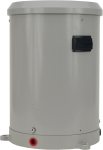
Ideal for high-intensity precipitation, even in freezing conditions






Overview
The CS700H, manufactured by HS Hyquest Solutions, is a high-end heated tipping bucket rain gage with an 8 in. orifice and a heavy duty cast aluminum base. It measures precipitation in 0.01 in. increments at temperatures down to -20°C. This heated rain gage is ideal for locations where intense rainfall events may occur, and it is used in environmental monitoring applications.
Read MoreBenefits and Features
- Extra-heavy metal construction for durability and long life
- Low power consumption
- More accurate measurement of high-intensity precipitation
- High precision—tips at 0.01-in. increments
- Accuracy is ±3 percent at high precipitation rates of 500 mm/hr
- Heater elements can run on either batteries or ac power
Images



Detailed Description
The CS700H funnels precipitation into a bucket mechanism that tips when filled to its calibrated level. Each tip is marked by a dual reed switch closure that is recorded by a data logger pulse count channel. After measurement, the water drains through two orifices (accepts 12 mm tubing) in the base, allowing the measured water to be collected in a separate container.
The CS700H contains an internal siphon mechanism that causes precipitation to flow at a steady rate to the tipping bucket mechanism (regardless of intensity). The siphon allows the sensor to make accurate measurements over a range of 0 to 50 cm per hour.
The CS700H includes an internal snow sensor that is activated when the air temperature drops below 4°C. If the snow sensor detects snow in the catch area (funnel), the heating elements automatically turn on and keep the funnel temperature at +10°C. To conserve power, the heater goes into a wait mode when snow has not been detected for 18 minutes. The heating element is also automatically deactivated when the air temperature drops below -20°C.
Compatibility
Please note: The following shows notable compatibility information. It is not a comprehensive list of all compatible products.
Data Loggers
| Compatible | Note | |
|---|---|---|
| CR1000 (retired) | ||
| CR1000X (retired) | ||
| CR300 (retired) | ||
| CR3000 (retired) | ||
| CR310 | ||
| CR350 | ||
| CR6 | ||
| CR800 (retired) | ||
| CR850 (retired) |
Additional Compatibility Information
Power Considerations
The CS700H has two power configuration options (either AC or DC). With the AC option, a Phoenix Contact Power Supply is shipped with the CS700H. With the DC option, the CS700H is connected to a user-supplied battery. This option is ideal for remote sites using wind or solar power to recharge the battery. Battery capacity requirements vary according to the application and site location.
Mounting
The base of the gage is supported by three legs. A CM240 Leveling Base and Mount or a user-supplied baseplate with leveling capability is recommended. The CM240 may be attached to a CM300-series mounting pole, or to a user-supplied 1.5 IPS (1.9-inch outer diameter, unthreaded) pipe (see Ordering Information). A concrete pad is recommended.
Wind Screen
Campbell Scientific offers the 260-953 Wind Screen to help minimize the affect of wind on the rain measurements. This wind screen consists of 32 leaves that hang freely and swing as the wind moves past them.
Specifications
| Sensor Type | Tipping bucket with siphon and dual reed switch |
| Measurement Uncertainty |
|
| Measurement Uncertainty | 700 mm/h (27.6 in./h) maximum rate per hour |
| Rainfall per Tip | 0.01 in. (0.254 mm) |
| Measurement Range | 0 to 700 mm/h (0 to 27.6 in./h) |
| Humidity Range | 0 to 100% |
| Cable Type | Two-conductor shielded |
| Operating Temperature Range |
|
| Output | SDI-12 |
| Total Current Consumption |
|
| Main Power Voltage Requirements | 10 to 30 Vdc or 12 to 28 Vac |
| SDI-12 Power Voltage Requirements | 9.6 to 16 Vdc |
| Drain Tube Size | Both filters accept 12 mm (0.47 in.) ID tubing. |
| Orifice Diameter | 20 cm (7.9 in.) |
| Height | 34.2 cm (13.5 in.) |
| Weight | 3.3 kg (7.4 lb) with 7.62-m (25-ft) cable |
CS700H-AC Option Only |
|
| -NOTE- | Additional specifications are provided in Phoenix Contact’s manual for the Quint-PS/1AC/24DC/10. |
| Model Name | Quint-PS/1AC/24DC/10 |
| AC Input Voltage Range | 100 to 240 Vac |
| Power Consumption |
|
| Protective Circuitry | Transient Surge Protection Varistor |
| Integrated Input Fuse | 6.3 A (slow blow, internal) |
| Normal Output Voltage | 24 Vdc ±1% |
Related Documents
Product Brochures
FAQs for
Number of FAQs related to CS700H-L: 12
Expand AllCollapse All


